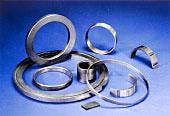Two new radar transmitters
Two new Rosemount radar transmitters available to the industry provide liquid level and interface measurement.
The multivariable 3300 (above) is a two-wire level and interface unit that allows simultaneous interface and level measurement in process tanks.
The 5600 Series noncontact unit (above) handles liquids and slurries.
The 3300. Using guided wave radar technology, a microwave radar pulse travels down a probe inside the tank and receives reflected signals from liquids levels or materials surrounding the probe.
Rigid and flexible probes are available, and they can be cut to length on site. There are probe versions for use in long nozzles, with small fittings/flanges, or in narrow bridles on separators. The modular construction allows the head electronics to be detached, freely rotated, or replaced without opening the tank. The single small diameter penetration for level and interface measurement makes a simple and inexpensive installation, the firm says.
The 3300 can be retrofitted onto existing loop cabling. It is available as intrinsically safe or explosionproof.
The 5600. This unit is available with a full range of antennas to suit any application.
Echo-tracking features and signal processing techniques combine to give the 5600 high reliability and accuracy, the company points out. The 5600 uses a software module that discriminates between false echo sources and true surface echoes. This software can also use information provided by the operator about stirrers or other obstructions as a complement to the automatically collected data.
Source: Emerson Process Management, 8200 Market Blvd., Chanhassen, MN 55317.
New software designed for pipeline route studies
A new GIS-based route planning suite of software tools is designed for offshore pipeline route studies.
The new suite enables a range of geographical datasets to be covisualized and queried on the geophysicist's PC, bringing quick delivery of comprehensive desk study results, the company says.
National hydrographic data, oilfleld infrastructure, previous survey data, wrecks, maritime boundaries, public domain marine information, and cable and pipeline databases are the data types generally accessed.
Bid response times are also aided by use of the suite, as all features and risks in the vicinity of a planned survey can be viewed and assessed quickly.
Virtually any geographical data can be added to the suite.
The CableDB database of global telecom and power cables is one of the major data types viewed in the suite. Cable position, status, ownership, armor type, and other attributes can be browsed and accessed.
Selected cable data can then be requested in multiple CAD or GIS formats such as Microstation DGN, AutoCAD DWG, Geomedia MDB, and ESRI shapefile to suit user requirements and rapidly be transmitted.
Source: Fugro Survey Ltd., Denmore Rd., Bridge of Don, Aberdeen AB23 8JW, Scotland.
Wellhead sensor helps position seabed equipment
The new Sub-Sea MDET Detector System is a versatile wellhead sensor.
It not only assists deepwater operators to position specialist equipment on the seabed, it detects the end of coiled tubing inside a riser.
This system makes it possible to see through steel tubulars via remote audible and visible warning system, making the process of proper equipment positioning more precise and controlled, the firm says.
The sensors clamp on to the outside of the riser. As a result, they don't interfere with equipment or other necessary activities being carried out on the seabed.
The warning system allows equipment to be positioned within an underwater riser with an accuracy of just a couple of inches.
The MDET works like this: A sensor is strapped around the riser from the wellhead.
It then detects the passing of a magnetic marker and relays this information to the cabin giving a visual and audible warning alarm to the operators.
Source: AnTech Ltd., Unit 7, Newbery Centre, Airport Business Park, Exeter, EX5 2UL, UK.
New carbon fiber material aids turbines, pumps
When extreme operating conditions lead to performance failures in bearings lubricated with oil, the new WR 575 carbon fiber technology offers an alternative.
The product is made from carbon fiber composite material that helps assure durability, corrosion and heat resistance, and reduced need for maintenance, even in extreme conditions.
The material suits it for sleeves, rings, and thrust pads used in gas turbines, steam turbines, centrifugal compressors, centrifugal blowers, centrifugal pumps, and gearboxes.
Source: Greeene Tweed & Co., 1930 Rankin Rd., Houston, TX 77073.
Free catalogs discuss downhole, transfer pumps
Two new, free catalogs discuss progressing cavity pump applications in downhole and transfer operations.
Downhole units offer flow rates of as much as 6,280 b/d and head capabilities of as much as 9,850 ft.
Pumps for transfer applications offer flow rates of as much as 2,200 gpm at pressures of as much as 725 psi.
Source: Moineau Oilfield Div., PCM Pompes, 17, rue Ernest Laval BP 35, 92173 Vanves Cedex, France.



